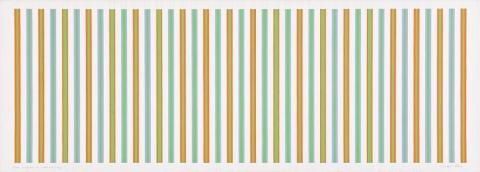GREEN SURROUNDED BY VIOLET AND ORANGE, 1969
BRIDGET RILEY
gouache on paper on canvas
74.0 x 206.0 cm
signed lower right: Bridget Riley
inscribed lower left: Green Surrounded by Violet and Orange
Lex Aitken, Sydney, acquired directly from the artist, London, 1973
'The conventional assumption is that a painting is an essentially passive thing: an inert, unchanging image over which the viewer's gaze roams freely. Her work shattered this expectation.'1
Green Surrounded by Violet and Orange is part of a significant suite of works painted by Bridget Riley in the late 1960s culminating in her monumental masterpiece in the Tate, London entitled Late Morning, 1967-68. Both works share the same minimal palette and rely on the repetition of interchanging vertical lines, which seem to pulse and glow as our eye travels over the work moving along each coloured thread. Her work literally creates a visual sensation obliterating any common sense of foreground or background giving every line equal status as we try in vain to fix our gaze. Colour is critical in this series of works. Riley introduced colour to her works in 1967 and thus allowed light to become a subject in itself. As Paul Moorhouse points out, once colour infiltrated her painting there was no chance of a hierarchy existing within the Riley composition. He writes, 'There is no possibility of setting up a stable situation because the experience of any colour is entirely relative: its appearance and behaviour depend on its context. In perceptual terms, every colour affects, and is affected by its neighbour. The basis of her work in colour is therefore "continuous" instability.'2
Among Riley's earliest forays in colour, Green Surrounded by Violet and Orange of 1969 is a progression of narrow vertical stripes, each one serving to interact and inform the next. The rhythm set up by this seemingly perfect application of the lines allows the white striped areas to both recess and obtrude and at times create a light 'haze' and a sense of atmosphere. The very essence of the pure colour she applies evokes nature. Riley herself comments, 'colour inevitably leads you to the world outside.'3 In Rise I in the Sheffield Galleries and Museum Trust, Riley flips the orientation so that the lines are now horizontal and no single line could be the horizon. A sense of endlessness is clearly at play here. Painted only one year after our painting, Persephone 2 of 1970 in the collection of N.M. Rothschild and Sons utilises the same mauve, green and orange. Riley makes one small adjustment in this slightly later piece and tapers the stripes to create an even further sense of optical disturbance to the point of being hallucinatory. In these works Riley masterfully shows the deep authority inherent in the simplest arrangement of colours and their sensory power to transform of perception.
1. Moorhouse, P., 'The Ultimate Secret of Things', in Bridget Riley: Paintings and Drawings 1961 - 2004, Museum of Contemporary Art, Sydney, 2004, p. 15
2. Ibid, p. 19
3. Ibid, p. 20
LARA NICHOLLS
